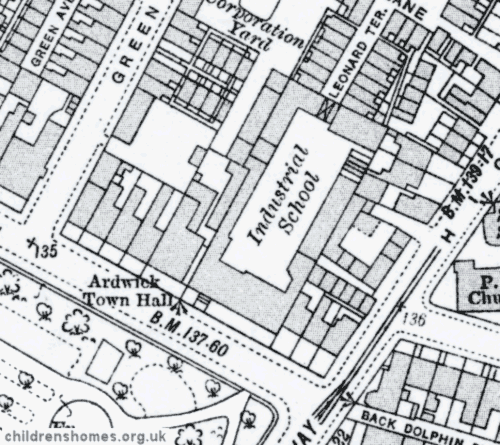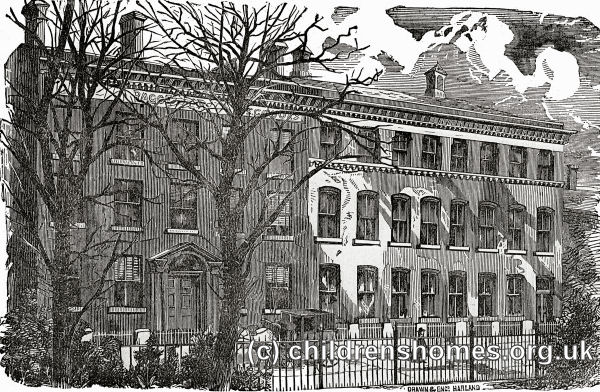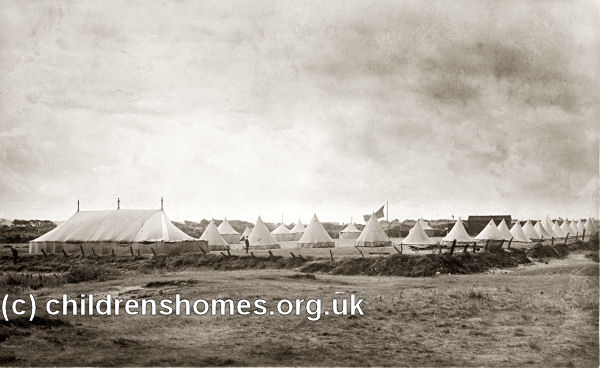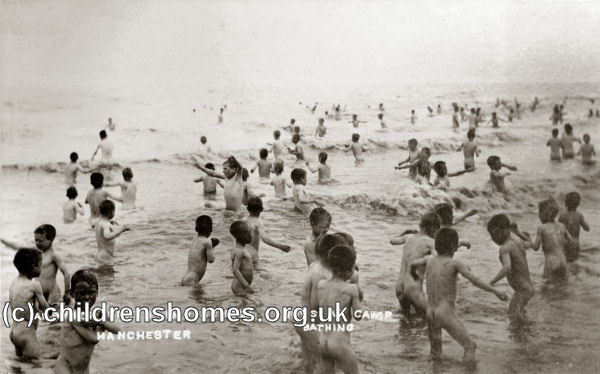Manchester Ragged and Industrial Schools / Industrial School for Boys, Ardwick Green, Manchester
The Manchester Juvenile Refuge and School of Industry was founded in 1846 at Nelson Street, Angel Meadow, Manchester. In 1851 it relocated to premises at St John's Parade, Byrom Street, becoming known as the Manchester Ragged and Industrial Schools.
On September 17th, 1857, another move took the establishment to 75 Ardwick Green, where a house and grounds were purchased for £2,000. Here, it was intended to provide lodging, maintenance, instruction, and industrial occupation for up to 100 young persons, and instruction, occupation and food for up to 200 children (both boys and girls). A new three-storey wing, designed by Alfred Waterhouse, was opened in October 1858 by Lord John Russell. The School fronted onto Ardwick Green North, immediately to the right of Ardwick Town Hall. The buildings ranged around a central quadrangle, used as a playground, with an arched entrance from Leonard Terrace at the far end.
On April 6th, 1859, the institution became a certified Industrial School, allowing it to receive children committed by magistrates for detention. Its residential capacity was set at 200 places. The establishment was now officially known as the Manchester Ragged and Certified Industrial School. An early inspection report on the School queried whether the handsome and imposing style of the buildings, and the extent to which the children are clothed and regularly boarded in it might be a drawback: 'such costly provision for the instruction and care of the ragged class may be more likely to increase the class than lessen it, tempting parents to let their children sink into it rather than deterring or stimulating them to keep them from it.' The superintendent in 1862 was the Rev. Joseph H. Bryan, with his wife as matron.
Further improvement to the premises in 1863-4 included the addition of an infirmary, enlargement of the girls' dormitory, and a partitioning of the boys' dormitory to allow better supervision. In addition to their school work, the boys were instructed in tailoring, shoemaking, printing, paper-bag making, firewood cutting and carpentry. The girls are were taught needlework, and the older ones assisted in the housework and laundry.
The School site is shown on the 1916 map below.

Boys' Industrial School, Ardwick Green, c.1916.

Ragged and Industrial Schools, Ardwick Green, 1860s.
In 1871, the School spawned a boys-only branch at Heaton Mersey, known as the Barnes Home. In the same year, following the death of Rev. Bryan, the Rev. T.T. Camm took over as superintendent, with Mrs Camm as matron.
In 1877, the girls were removed to their own establishment at Sale and from that date Ardwick Green remained a boys-only School. In June of that year, Mr and Mrs Thomas Jackson succeeded the Camms as superintendent and matron. They held their posts until their retirement in 1890 and were then replaced by Mr and Mrs Angus Mackay.
An inspection in 1890 recorded that 15 boys were working with the tailor, 24 with the shoemaker, and 16 with the joiner. The printing shop had been extended, and the work more largely developed. Some of the junior boys did knitting, sewing, and mending; four boys worked as bakers, six as cooks. Many of the juniors attend school all day. The School had efficient band and the boys drilled well. The other staff at the School now included: schoolmasters, Messrs. B. Harrison, Oakes, and Walker; clerk, tailor, shoemaker, printer, joiner, baker, engineer, assistant matron, sewing mistress, laundress, cook, housemaid; and a drill and gymnastic master (occasional).
Mr and Mrs Andrew Ross, who succeeded the Mackays as superintendent and matron, departed in March 1896. The head schoolmaster, James Allison, and his wife then took charge. A report in the same year noted that the interior of the front building was 'cheerful', as were the dormitories, school rooms and dining-room, with ample heating throughout. The wing buildings mainly taken up with workshops, boiler-house, play-shed etc. The printing department was about to be discontinued. Physical training now included swimming, drills with dummy rifles and bayonets, and weekend walks. Life saving was made a special feature in the swimming instruction. The School's only play-field was a public park, however. A recreational evening class in repoussé had been introduced in the winter.
In July-August 1897, the went to camp at Prestatyn for a fortnight. A summer camp of two or three weeks became an annual event for the inmates.

Ardwick Green Boys' Industrial School, at camp, early 1900s.

Ardwick Green Boys' Industrial School, swimming at camp, early 1900s.
In November 1900, an Auxiliary Home was opened a few doors away at 59 Ardwick Green. It provided supervised hostel-style accommodation for older boys who were making the transition from the School to independent life, working for employers in the area. Initially housing 20 boys, its certified accommodation was increased to 35 places in March, 1901.
In around 1910, plans began to be made for the School to move to new premises outside the city. The following year, a 31-acre site was purchased at Cheadle Hulme and it was reported that building operations were hoped to begin in the early spring of 1912. The proposed cost of the new building, the declining numbers being committed to Industrial Schools, and the advent of the First World War all conspired against the scheme and it was eventually abandoned.
The School eventually closed in 1922. The site was subsequently occupied by St Gregory's Roman Catholic Technical High School, then St Gregory's Grammar School. The buildings no longer survive.
The Auxiliary Home continued in use after the School's closure, presumably serving the Barnes Home. In October, 1924, the Home — address now recorded as 61 Ardwick Green — was certified to accommodate 32 boys.
Records
Note: many repositories impose a closure period of up to 100 years for records identifying individuals. Before travelling a long distance, always check that the records you want to consult will be available.
- Greater Manchester County Record Office (with Manchester Archives), Archives+, Manchester Central Library, St Peter's Square, Manchester M2 5PD. Holdings include: Admission registers (1866-1921); Discharge registers (1896-1906); Annual reports; Licensing registers; Medical reports; Punishment books; Annual reports; Committee minutes; etc.
- Admission registers (1866-1912) and Discharge registers (1896-1906) are also available online on Find My Past.
Census
Bibliography
- Higginbotham, Peter Children's Homes: A History of Institutional Care for Britain's Young (2017, Pen & Sword)
- Mahood, Linda Policing Gender, Class and Family: Britain, 1850-1940 (1995, Univeristy of Alberta Press)
- Prahms, Wendy Newcastle Ragged and Industrial School (2006, The History Press)
Links
- None noted at present.
Except where indicated, this page () © Peter Higginbotham. Contents may not be reproduced without permission.


